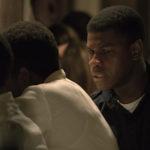
ReelBob: ‘Detroit’ ★★★½
By Bob Bloom
“Detroit” is unrelenting; its violence, viciousness and racism constantly assault you. It’s a gut-wrenching movie not meant for those with sensitive dispositions.
Director Katherine Bigelow’s latest project makes you squirm and feel helpless and uncomfortable — which is exactly how she wants you to react.
The film steps on your neck, cutting off your air and daring you to attempt looking away.
“Detroit” is set during the summer of 1967, when racial strife gripped the nation, leading to riots in cities, such as Los Angeles, Newark and the Motor City.
As an animated prelude to the storyline explains, tensions between the Detroit police department — which was mostly white — and black citizens — many of whom had left the segregated South in hopes of finding better jobs and living conditions in the North — had been bubbling for several years.
The flames were fanned, leading to an eruption, after the closing of an after-hours club and the arrest of several patrons in the black section of the city.
Rioting and looting commenced. Police, many armed with shotguns, and, later, the National Guard tried to clear the streets to quell and contain what had become a racial revolution.
Deadly mistakes ensue as jumpy and nervous Guardsmen and police become trigger happy.
The movie’s main focus is an incident at the Algiers Hotel in which a trio of white police officers who were searching for a sniper killed three black men. (The incident began when a young black man at the hotel had fired blanks from a starter pistol from his window at passing officers and Guardsmen.)
The officers use the incident to initiate a night of intimidation, brutality, racist tirades and murder. They roust a group of young men from their rooms, putting them against walls and threatening to shoot them if they don’t reveal the shooter or the location of the weapon.
Things get worse when the police discover two young white women socializing with the men.
No words can adequately describe the harrowing scenes created by Bigelow and screenwriter Mark Boal — who collaborated on “Zero Dark Thirty.”
What happens in that motel is an onslaught upon your senses. The hatred and racism spewed by the officers, their constant mental torture of their prisoners and the seemingly joy they get from the power they have over their helpless charges is reprehensible.
Plus, Bigelow, using various close-ups, keeps us right in the middle of it all. We are impotent, silent witnesses who know what is coming but can do nothing to stop it.
What is just as bad is the complicity displayed by the inaction of Michigan State Police and National Guard personnel who realize what is happening, but decide to ignore the situation because they do not want to become involved.
With the exception of a couple prisoners, we don’t learn much about the backgrounds of the people in the motel. And it does not seem necessary. Bigelow is trying to put us in the shoes of the police officers who single-mindedly see these men as menaces without knowing anything about them.
The worst of these offenders is Krauss, portrayed by Will Poulter. The man reeks of self-righteous racism, using his badge as a shield to exact deadly force and boldly display his bigotry and disgust with his prisoners.
John Boyega plays Dismukes, the most conflicted character. He is a security guard at a grocery store whose approach to trouble is to  remain calm and use his verbal skills to defuse situations.
remain calm and use his verbal skills to defuse situations.
The store he is watching is near the Algiers, so he heads there to see if he can help.
Dismukes’s main purpose is to attempt keeping confrontations from escalating, thus saving lives.
But at the motel, he is intimidated by the police officers. He remains mostly mute, trying to appease the officers by attempting to help find the weapon.
He watches their brutality, but remains quiet, hoping beyond hope that the officers see reason.
Later, he realizes his silent complicity makes him partially responsible for the deaths.
One of the film’s most telling moments comes after the deadly incident when the officers and Dismukes are on trial for murder. Row upon row of Detroit police officers sit in the courtroom in full uniform, stone-faced, showing solidarity for their comrades, despite their disgraceful actions.
“Detroit’s” main flaw is Bigelow and Boal’s decision to cover the post-riot events, most notably the trial.
This last act feels anti-climactic. It is neither cathartic nor necessary. It deflates the emotional intensity you have experienced.
You don’t even feel badly for Dismukes who, after the verdict, runs outside the courthouse to vomit after Krauss compliments him, condescendingly patting him on the shoulder and calling him a “stand-up guy.”
Yes, those sequences allow you to catch your breath. I, however, could have done without the respite.
The real tragedy of “Detroit” is that 50 years after this heinous event, cops similar to those portrayed in the film, still exist — thankfully, as a smaller minority.
The bigger pity is that, as in the film, good and decent officers either continue to keep silent or turn a blind eye.
Bob Bloom is a member of the Indiana Film Journalists Association. His reviews appear at ReelBob (reelbob.com) and Rottentomatoes (www.rottentomatoes.com). He also reviews Blu-rays and DVDs. He can be reached by email at bobbloomjc@gmail.com or on Twitter @ReelBobBloom.
DETROIT
3½ stars out of 4
(R), graphic and bloody violence, disturbing images, language
